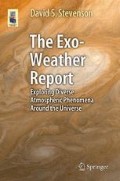Abstract
This chapter illustrates the fluid nature of planetary weather and climate. Climate is a dynamic creature that changes with the activity of the planet’s central star, the Sun, and with other dynamic forces that operate on and within planets. The climate of the Earth has repeatedly changed dramatically over the eons since it has formed.
Access this chapter
Tax calculation will be finalised at checkout
Purchases are for personal use only
Notes
- 1.
This is an absolute minimum with the likely volume exceeding three million cubic kilometers, or more than twice the Deccan Traps in India.
- 2.
- 3.
- 4.
While going to press, Som has published another research article in the journal Science that suggests that the density of the atmosphere was actually a lot lower than it is now.
- 5.
Finding any definitive value for the height of tides seems to be more trouble than it’s worth! Values range from 1 to several tens of meters with few references giving anything conclusive. Take 30 m as speculative…
References
Zahnle, K., Arndt, N., Cockell, C., Halliday, A., Nisbet, E., Selsis, F., et al. (2007). Emergence of a habitable planet. Space Science Reviews, 129, 35–78.
Fernando S. Paolo., Helen A. Fricker., Laurie Padman (2015). Volume loss from Antarctic ice shelves is accelerating. http://www.sciencemag.org/content/early/2015/03/31/science.aaa0940.
Svensen, H., Planke, S., Malthe-Sørenssen, A., Jamtveit, B., Myklebust, R., Eidem, T. R., et al. (2004). Release of methane from a volcanic basin as a mechanism for initial Eocene global warming. Nature, 429, 542.
Leconte, J., Forget, F., Charnay, B., Wordsworth, R., & Pottier, A. (2013). Increased insolation threshold for runaway greenhouse processes on Earth-like planets. Nature, 504, 268–271, doi:10.1038/nature12827.
Som, S. M., Catling, D. C., Harnmeijer, J. P., Polivka, P. M., & Buick, R. (2012). Air density 2.7 billion years ago limited to less than twice modern levels by fossil raindrop imprints. Nature, 484, 359–362.
Rosing, M. T., Bird, D. K., Sleep, N. H., & Bjerrum, C. J. (2010). No climate paradox under the faint early Sun. Nature, 464, 744–749.
Mitchell, R. N., Kilian, T. M., & Evans, D. A. D. (2012). Supercontinent cycles and the calculation of absolute palaeolongitude in deep time. Nature, 482, 208–211.
Hansen, J., Ruedy, R., Sato, M., Imhoff, M., Lawrence, W., Easterling, D., et al. (2001). A closer look at United States and global surface temperature change. Journal of Geophysical Research, 106, (D20) 23947–23963.
Travis, D. J., Carleton, A. M., & Lauritsen, R. G. (2002). Climatology: Contrails reduce daily temperature range. Nature, 418, 601.
Pollard, D., & DeConto, R. M. (2009). Modelling West Antarctic ice sheet growth and collapse through the past five million years. Nature, 458, 329–333.
Naish, T., Powell, R., Levy, R., Wilson, G., Scherer, R., Talarico, F., et al. (2009). Obliquity-paced Pliocene West Antarctic ice sheet oscillations. Nature, 458, 322–328.
Kossin, J. P., Emanuel, K. A., & Vecchi, G. A. (2014). The poleward migration of the location of tropical cyclone maximum intensity. Nature, 509, 349.
Michael E Mann. (2002). The Earth system: Physical and chemical dimensions of global environmental change Volume 1, (pp. 504–509). In Michael C MacCracken & Dr John S Perry (Eds.), Encyclopedia of global environmental change. New York: John Wiley & Sons. ISBN: 0-471-97796-9 Editor-in-Chief Ted Munn.
Hoffman, P. F., Kaufman, A. J., Halverson, G. P., Schrag, D. P., Hoffman, P. F., Halverson, G. P., et al. (1998). A Neoproterozoic snowball Earth. Science, 281, 1342–1344.
Peterson, T. C., Gallo, K. P., Lawrimore, J., Owen, T. W., Huang, A., & McKittrick, D. A. (1999). Global rural temperature trends. Geophysical Research Letters, 29(3), 329–332.
DeConto, R. M., Galeotti, S., Pagani, M., Tracy, D., Schaefer, K., Zhang, T., et al. (2012). Past extreme warming events linked to massive carbon release from thawing permafrost. Nature, 484, 87–90.
Wignall, P. B., & Twitchett, R. J. (1996). Ocean anoxia and the end Permian Mass extinction. Science, 272, 1155–1158.
Daniel H. Rothmana., Gregory P. Fournierc., Katherine L. Frenchb., Eric J. Almc., Edward A. Boyleb., Changqun Caod., & Roger E. Summons. (2014). Methanogenic burst in the end-Permian carbon cycle. Proceedings of the National Academy of Sciences, 111 no. 15 > Daniel H. Rothman, 5462–5467, doi: 0.1073/pnas.1318106111.
Author information
Authors and Affiliations
Rights and permissions
Copyright information
© 2016 Springer International Publishing Switzerland
About this chapter
Cite this chapter
Stevenson, D.S. (2016). Tales of Mass Destruction. In: The Exo-Weather Report. Astronomers' Universe. Springer, Cham. https://doi.org/10.1007/978-3-319-25679-5_3
Download citation
DOI: https://doi.org/10.1007/978-3-319-25679-5_3
Published:
Publisher Name: Springer, Cham
Print ISBN: 978-3-319-25677-1
Online ISBN: 978-3-319-25679-5
eBook Packages: Physics and AstronomyPhysics and Astronomy (R0)

